
Nobody likes to be the new guy at the office.
When you join a new workplace, you’re not yet comfortable in your new surroundings, you don’t know how things work or where to start.
It isn’t pleasant—and we’ve all been there at least once.
We know that you don’t want that feeling to overwhelm your new developers, so in this article, we’ll provide you with the best tips for onboarding them.
Follow them, and your new team members will have a smooth start at the company.
Table of Contents
Prepare all resources before their first day
Imagine if a new developer came in on their first day just to find that they have an empty desk and no idea what they should be doing for the rest of the day.
It’s fair to say that making them face such a predicament wouldn’t project a professional image of the company.

Get unreal data to fix real issues in your app & web.
That’s why you should prepare everything you can before your new developer’s first day.
For instance, 18F, a digital consultancy agency for the U.S. Government, has a carefully constructed onboarding process.
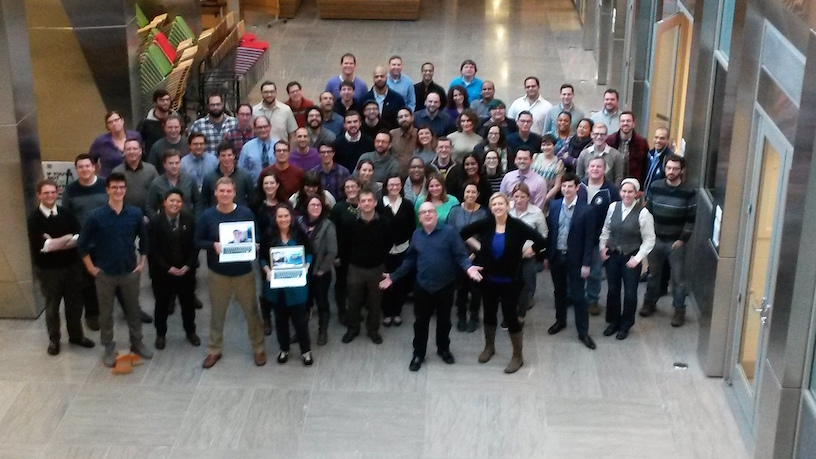
In addition to sending their new hires a series of emails with forms to fill out and all the necessary information for their first day, the Operations team sets up a new laptop, a phone, and an email address.
You can do something similar, and even encourage your new hires to start their training before their first day if you have prepared resources.
That’s what Salesforce does; they send their new employees an email with a link to Trailhead, a free learning platform.

As they explain, they want to make sure that their employees can dive right in from the first day on the job.
“There, employees can take various courses in preparation for their first day, watch videos and more.”
Preparation is something that they take seriously at Facebook, too.
The company is known for its 45-minute rule—a notion that an employee has to start doing something productive within the first 45 minutes.
As Timothy Campos, their former chief information officer, explained, all systems and devices are calibrated before new hires report for their first day.
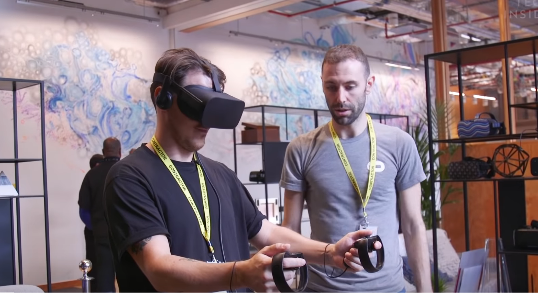
What else can you do before your new developers’ first day? Here are a few more ideas; some of them we’ll explore in more detail in later sections:
- Set up access to project management systems
- set up access to testing environments
- provide access to internal company documentation
- install tools necessary for their work
Of course, you could do even more, but the point is that your newcomers can come in on the first day and have an organized working environment.
That could be a promising start to their career at your company.
Present your company culture
Every new employee wants to fit in their new workplace, and developers are no exception. One of the best ways to do that is to adopt a company culture.
However, if you want your developers to adopt it, you should set up a way to efficiently present it and immerse them in it.
And most of them consider company culture a very important part of their new environment and workplace experience.
According to a survey by Glassdoor, for 56% of workers, company culture is even more important than salary.
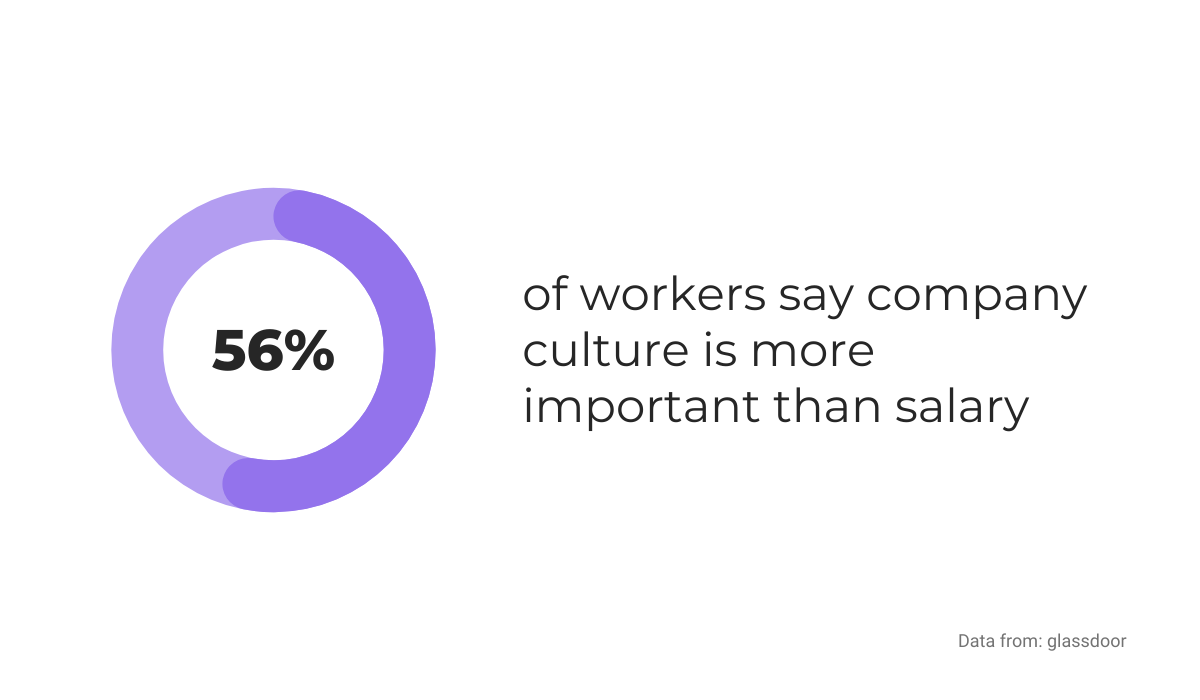
Therefore, whether you have a particular dress code at your company, communication guidelines, or any other of many details which comprise a company culture, you should present them to your new hires.
One of the ways to do that is by creating an employee handbook. Many companies use a guide like that to introduce workplace rules to their employees.
For example, Trello has an interesting solution; they created their Employee Manual using the Trello dashboard.

As you can see, each board covers a different topic, like employee benefits or vacation policies.
It’s a clever way to introduce their company culture while presenting the functionality of their product to new developers.
Another approach could be with videos, like a house cleaning and maid service company MaidPro does.
They created videos that focus mainly on company culture and community as a convenient way to introduce those elements to their new employees.

For example, the screenshot above is from a video with highlights from one of their conventions.
Other videos may show their team buildings or activities in the office—in short, it conveys what their company culture is about.
Effectively immersing your newcomers in your company’s culture is one of the essential parts of onboarding.
The sooner they start to feel like a part of the team, the sooner they’ll deliver their best work.
Give them access to all the tools they’ll need
Your new developer would likely want to get started on their tasks as soon as possible. After all, they didn’t come to your team to waste time.
Providing them with access to all the tools they need will streamline the onboarding process.
Whether they’re already familiar with the tools your team uses or not, they need the access to get started.
You can leave them with installed software and the instructions on how to use it; there’s nothing wrong with that, and most developers would figure everything out by themselves.
However, you can combine giving access to tools with an actual onboarding task for a newcomer, as Zapier does.
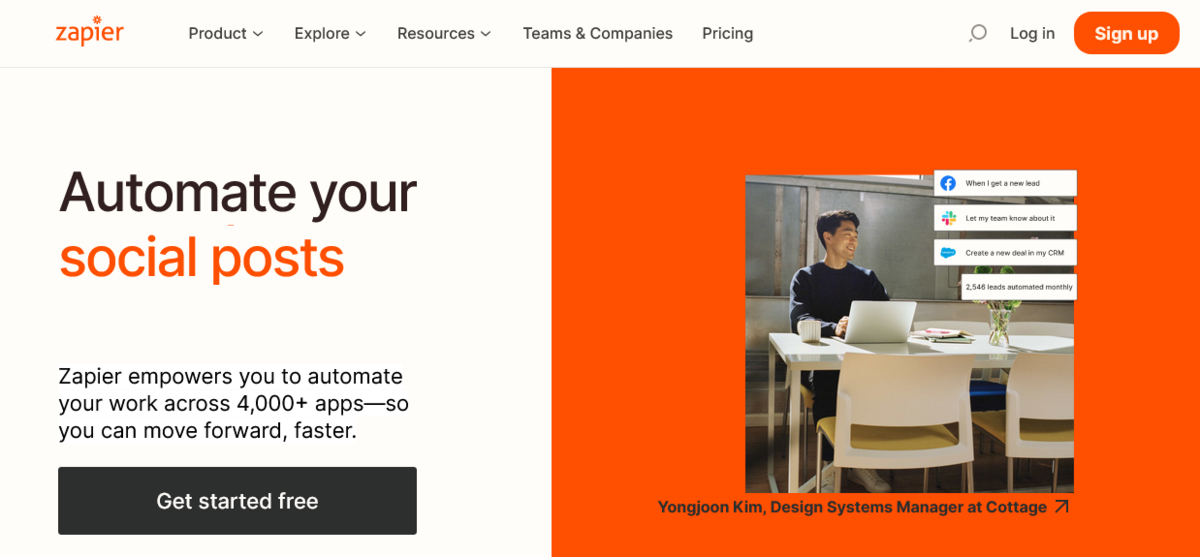
As they describe in an article on their onboarding process, they usually set up a dev environment on the second or third day of the onboarding process.
Then, they assign a small task to the new developer. The task doesn’t require a lot of company-specific knowledge.
Still, it encourages the newcomer to start using the tools they’ll need in their day-to-day work.
For example, one new developer was asked to update the Google Sheets integration with an Add column action.
That task required them to access Google Sheets, familiarize themselves with the code and experience the workflow through tools they use at Zapier.
Similarly, you can give access to the tools to a new developer, along with a small task.
For example, if your new hire will use Atom in their work, you should provide access to it so they can familiarize themselves with the workflow.
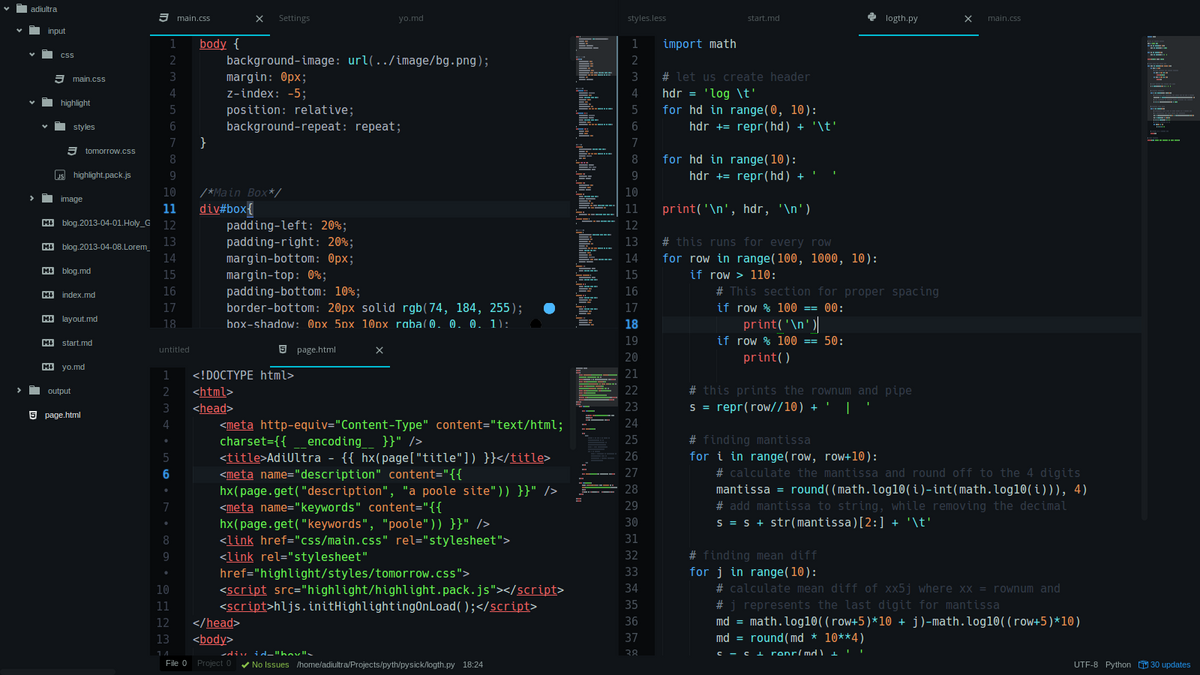
Or, if you use ESLint, a code analysis tool, you can give your new developer a task to run a piece of code through it and see how it is customized for the project they’ll work on.
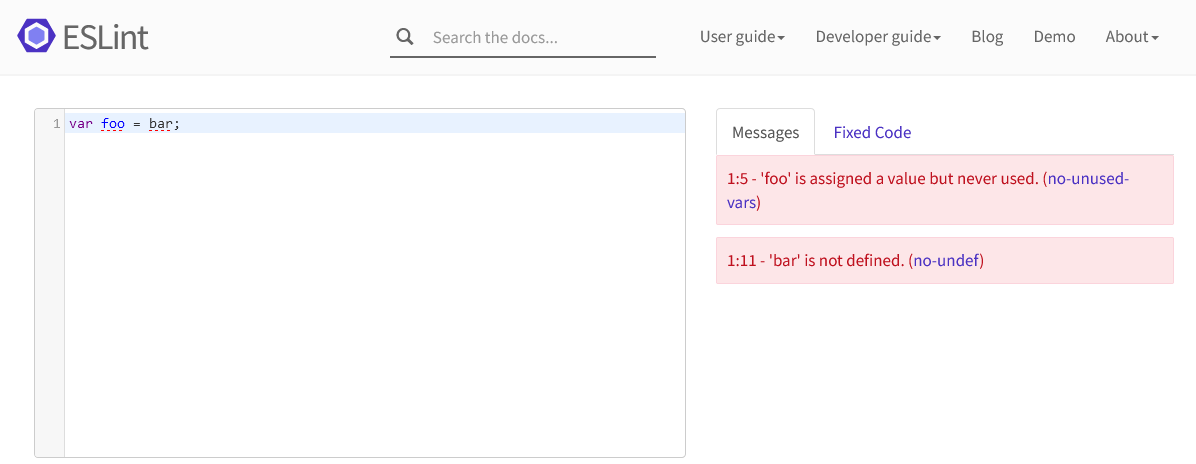
By giving your new developers access to the tools they need, you avoid unnecessary time-wasting and make your onboarding process more efficient.
Combining that with introductory tasks allows your developers to have a flying start.
Give them access to your technical documentation
When your new developers arrive, they’ll most likely feel the burden of a considerable amount of new information.
When it comes to the technical part of their job, you can help them out by giving them access to your technical documentation.
The sooner they start reading the technical documentation, the better – they can’t start working on the project without knowing its details and how to work on it.
Technical documentation encompasses a wide range of materials dealing with software development, so there’s a lot that your new developers should have access to, like:
- product requirement document
- UX design documentation
- software architecture design document
- source code document
- quality assurance documentation
- user documentation
And every one of those categories has at least a few essential documents; it’s a good idea to let your newcomers start on all of them during onboarding.
There are plenty of tools for organizing and sharing internal documentation; you can use a solution like Tettra.
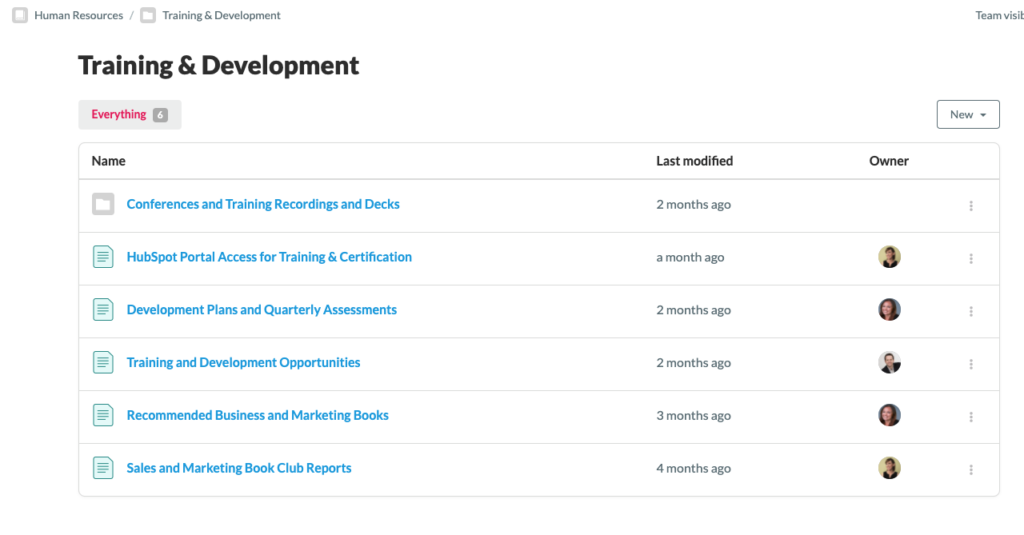
Above, you can see a part of the documentation from SmartBug, a marketing agency.
Tettra and other similar internal knowledge bases are easy to update, they are searchable, and you can share the resources with anyone you like, including new developers.
Zapier, a company we mentioned earlier, is also big on technical documentation. They have an internal knowledge base with articles on many technical topics.
“If a new hire wants to know how to spin up the dev environment, deploy to production, or perform a code review, we’ve got an internal knowledge base in Quip with articles on each topic.”
They also record videos of the system architecture and capture conversations about code; that way, a newcomer has rich resources to learn from.
In addition to being in a completely new environment with new colleagues, your new developers need to quickly figure out all the technical details about the projects they’ll be working on.
Giving them access to your documentation can make the latter much easier.
Introduce them to future colleagues
Part of the onboarding process for your new developers should be introducing them to their colleagues—after all, they’ll share successes, setbacks, and a big portion of their day with them for some time.
Socializing is a significant factor in the best onboarding programs. According to research done by Brandon Hall Group for Glassdoor, a third of high-performing onboarding programs include it.
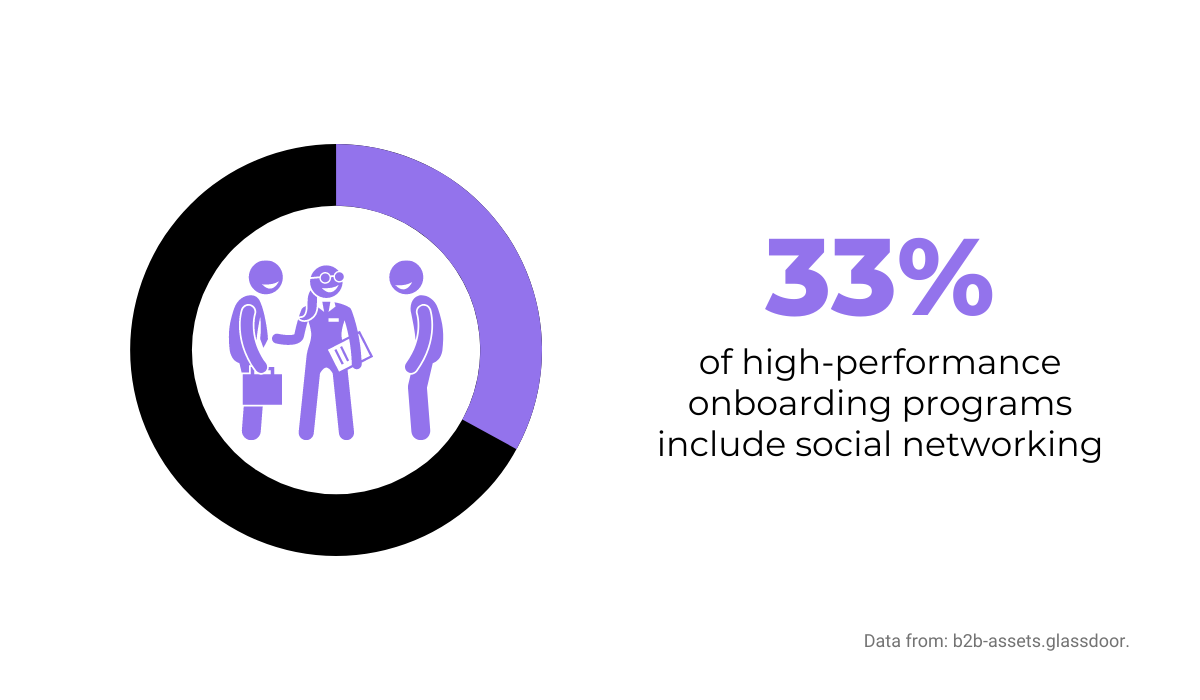
Therefore, employers who take onboarding seriously consider the social aspect a vital part of the experience.
That’s the case with Bazaarvoice, a B2B software company. They bring all their new hires to their headquarters in Austin, Texas, for the onboarding process.
One part of the process is a scavenger hunt related to the company’s products and culture, which includes plenty of socializing and opportunities to meet their new colleagues.
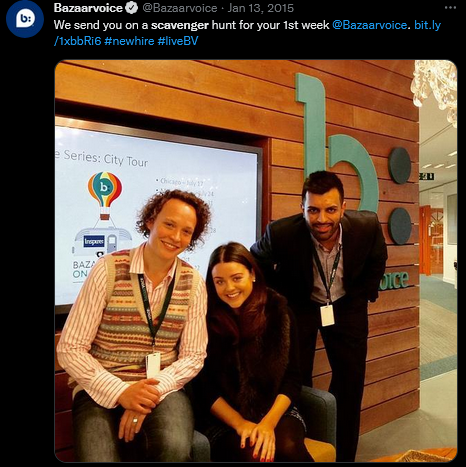
For example, a new employee has a task to set up a video call with a remote co-worker, answer trivia questions and organize a snack break for the entire office.
As Andy North, their former vice president of brand and communications, explained it, besides good food, there are also plenty of social benefits to that practice.
“We’ve had good feedback from the new employees that it’s a fun way to break the ice and meet their new colleagues.”
In the end, the newcomers introduce themselves to the whole company via a global video call and ring a gong—a tradition in the company.
A company scavenger hunt and a lunch are good ways to introduce new hires to their colleagues, but what if your developers work remotely?
Luckily, there’s a way around that with today’s technology. For example, 360learning, a collaborative learning platform, organizes a virtual drink or meal to break the ice.
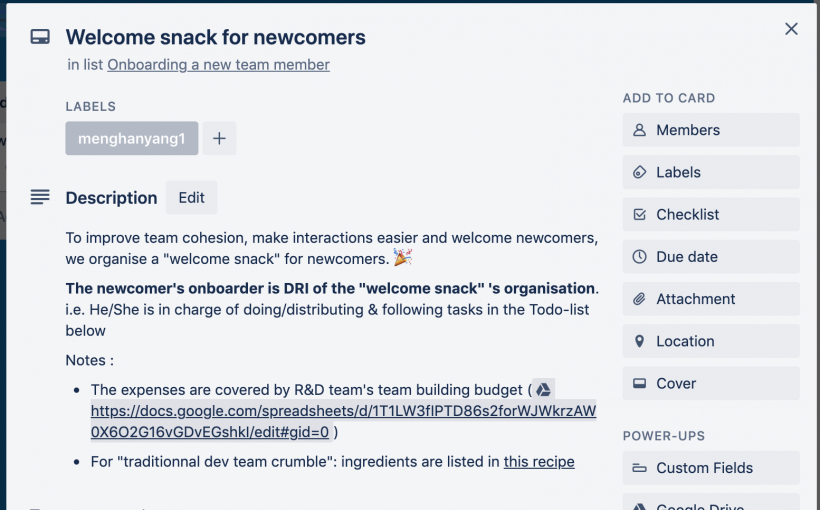
A newcomer is in charge of the to-do list, and they organize the event, which even includes “traditional dev team crumble”.
Even via a video call, sharing a meal can be a great way to connect your newcomers to your team.
Whether your team works at the office or at home, there’s always a way to make them a cohesive unit.
Assign an onboarding buddy
An onboarding buddy is one of the most efficient methods to help your newcomers become a part of the team.
Imagine having a guide to everything in your workplace, from technical details about the code to quirks of the office coffee machine—in a nutshell, that’s an onboarding buddy.
It’s best to assign a more experienced employee to your new developer so they can make them acclimate to their new surroundings.
As Gabrielle Schofield from Amazon puts it, an onboarding buddy is there to answer any questions that a newcomer might have.
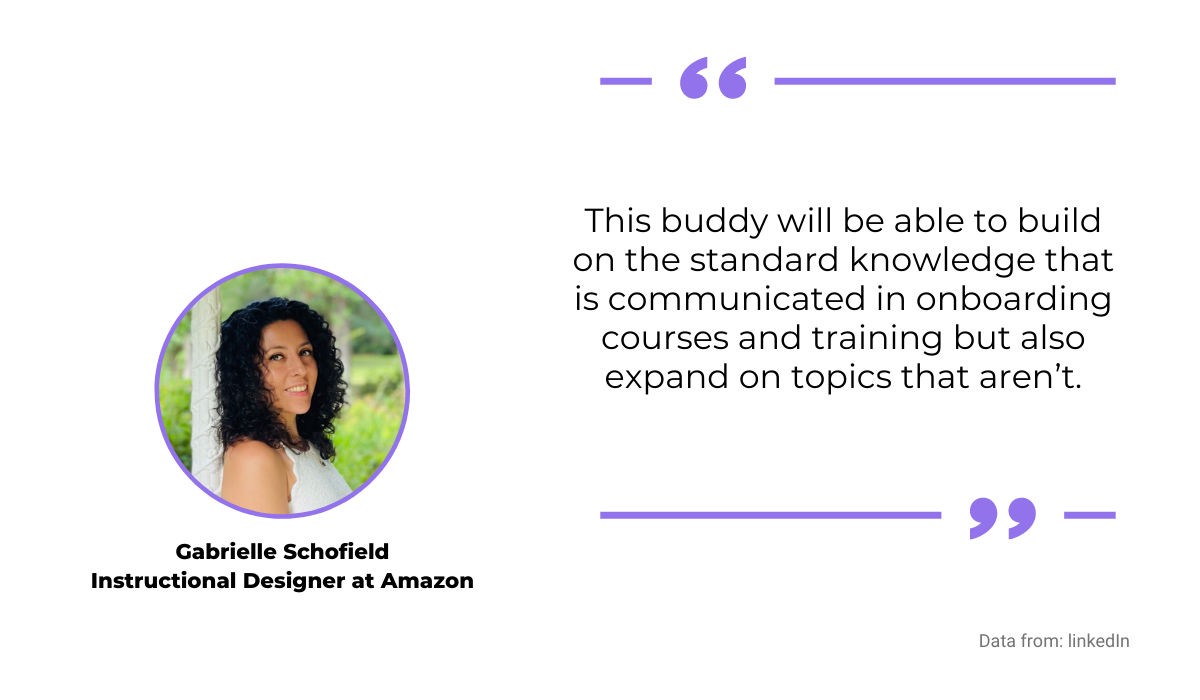
Even if you have the best onboarding courses and impeccable documentation, you can’t cover all the possible topics and doubts that your new developer can have.
That’s why many companies recognize how helpful it can be for a newcomer to have an experienced co-worker by their side.
According to research by HCI, cited on g2, 87% of companies claim that it’s a very effective method for onboarding.
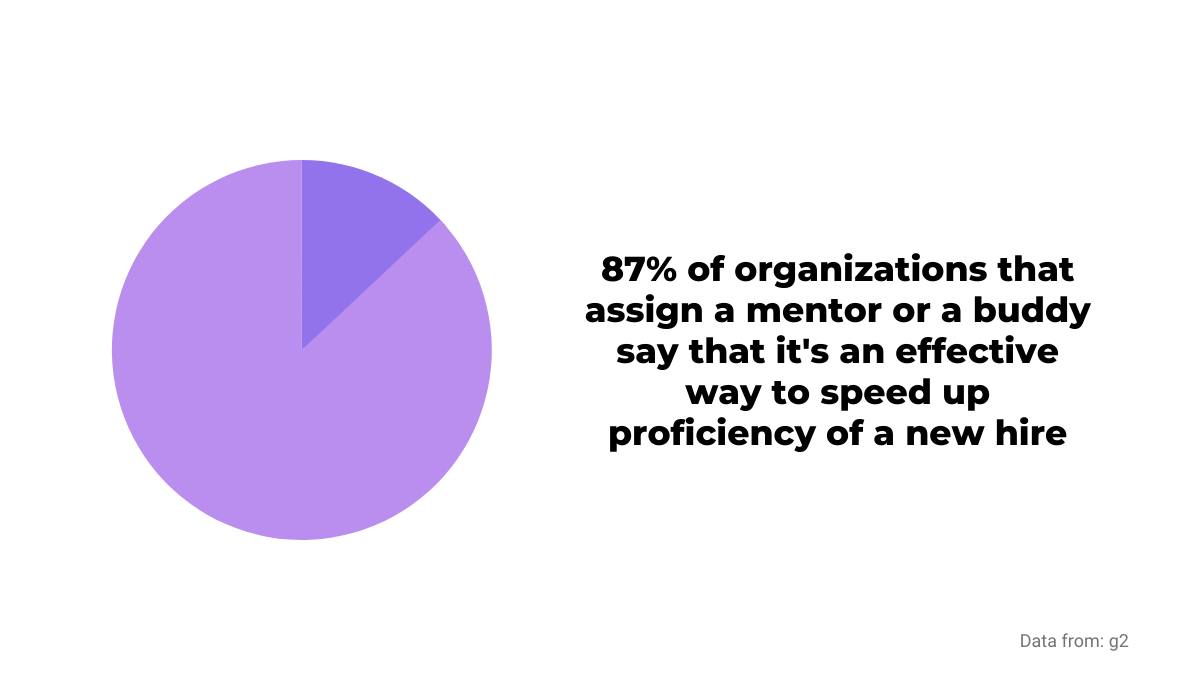
One of the companies best known for its structured approach to the onboarding buddy system is Buffer.
This tech company assigns not one, not two, but three buddies to their newcomers. More specifically, a new employee gets a hiring manager, a role buddy, and a culture buddy.
A hiring manager is a direct supervisor who organizes a newcomer’s onboarding process, gives feedback, passes on valuable information, etc.
A role buddy works in the same team as a new employee or has a similar role elsewhere in the company. They are the go-to person for any questions related to tasks or a role.
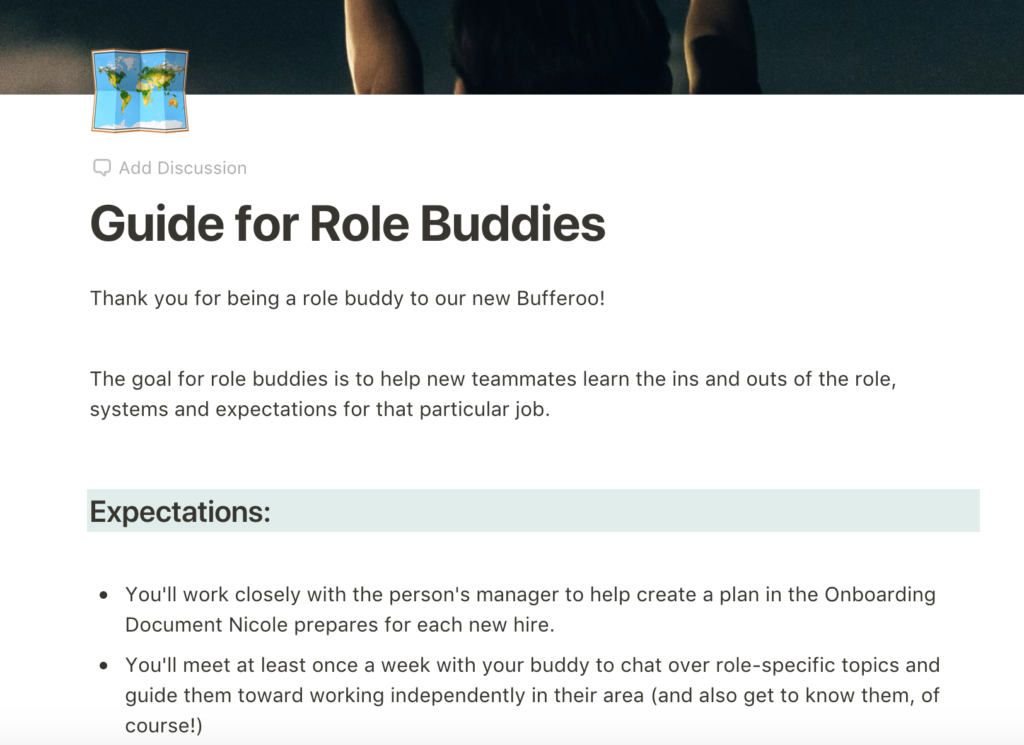
Finally, there’s a culture buddy. Their role is to guide the newcomer through culture-related topics and values of the company, provide corrective feedback, etc.
Buffer’s system is highly structured, and not every company can assign three buddies.
However, even one experienced and patient employee can make a newcomer’s first weeks at the new company much easier.
Ask for feedback regularly
How can you know if your onboarding process is the experience you intended for your newcomers? The most direct and efficient way is simply to—ask.
Gathering feedback about the onboarding process can be very helpful; it can show you what areas you need to improve and what you’re doing right.
And that can result in a higher retention rate.
According to data, a fulfilling onboarding experience impacts employees’ satisfaction; nearly 70% of them will stay with the employer for three years or more if they experience good onboarding.
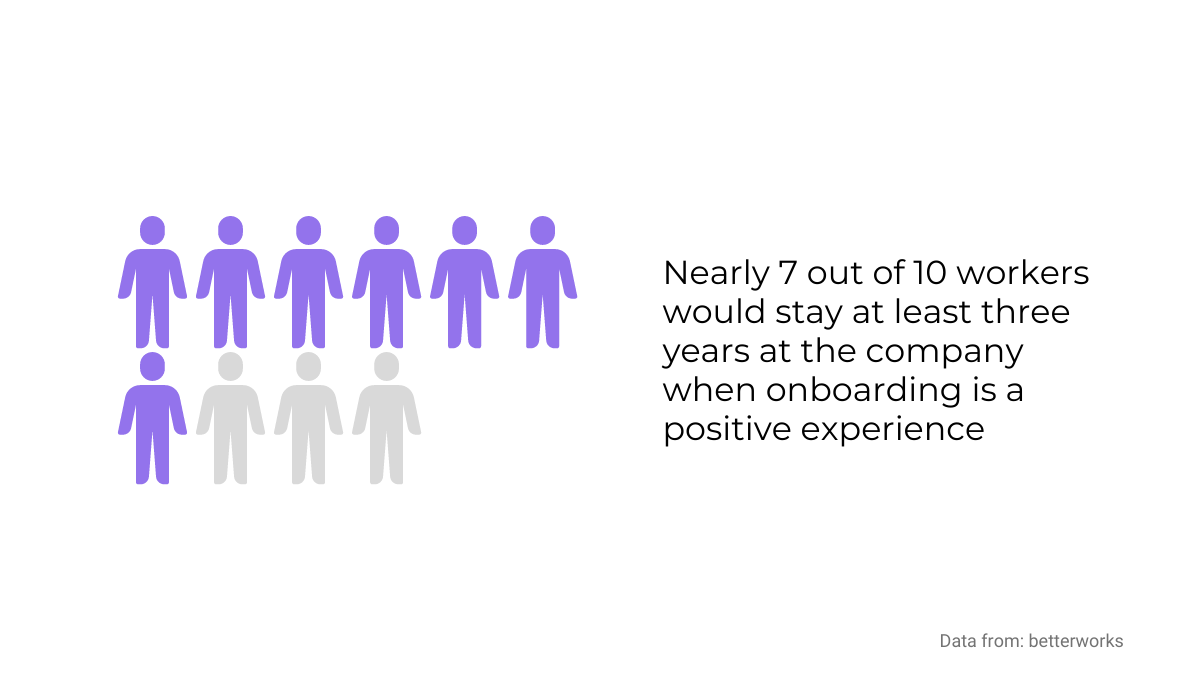
You can ask for feedback in many ways, and one of them is having regular meetings with new developers during their onboarding.
For example, CareZone, a software development company, organizes regular developer lunches which allow developers to talk about issues and get support.

You can ask for feedback in a casual setting like that; the important part is taking an interest in the experience of your newcomers.
That will make them feel valued, and it facilitates openness and honesty as fundamentals of your relationship, which is undoubtedly a plus.
Another way to get feedback is with a poll. That can be very simple with software solutions like Polly.
You can create surveys and embed them in Slack or Microsoft Teams to make it as convenient for your employees as possible.
Also, it has a few dozen templates, like the one below about the first 30 days on the job.
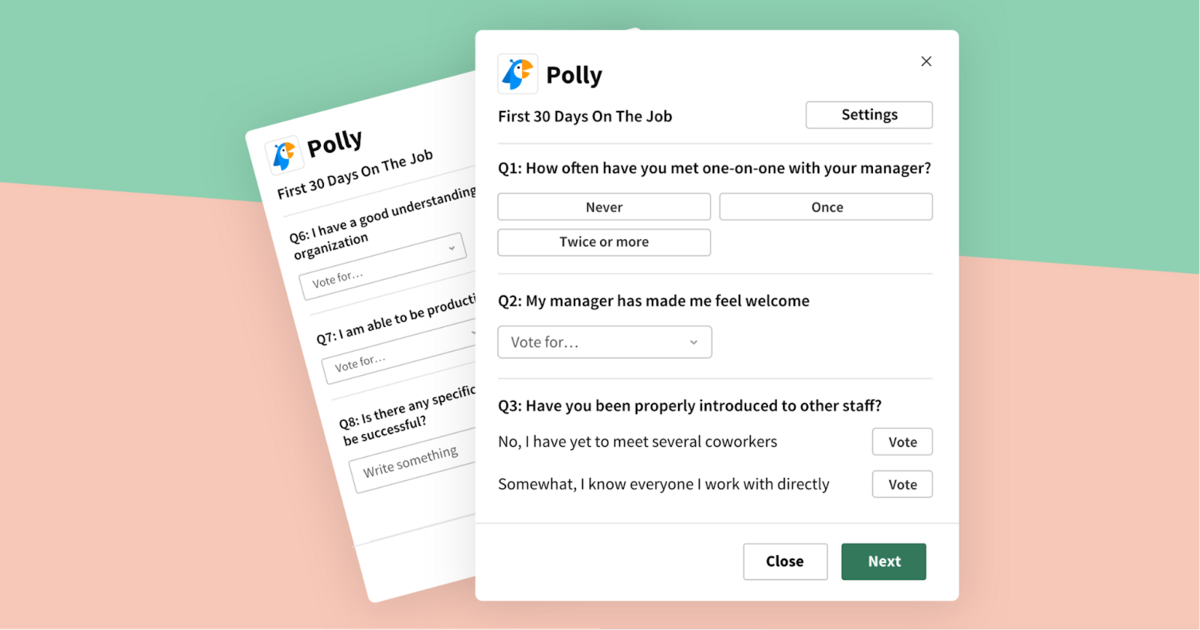
Of course, it allows you to create your own surveys, use open-ended and multiple-choice questions, rating scale, etc.
Your preferred method of asking for feedback from your newcomers isn’t crucial; the vital part is to ask for feedback in the first place.
Your employees will feel like you care, and you’ll have valuable information about the onboarding process—it’s a double win.
Conclusion
Not all companies onboard their employees.
Some don’t want to spend time and resources on gradually introducing newcomers to their workplace. After all, they’re developers; they’ll figure it out, right?
Some will, but why would you give them a challenging start, compromise your projects, and leave them with a bad first impression? It’s not productive or efficient.
However, proper onboarding is crucial if you want happy employees who’ll perform to the best of their potential.
Use the tips from this article to make sure your onboarding process achieves just that.




